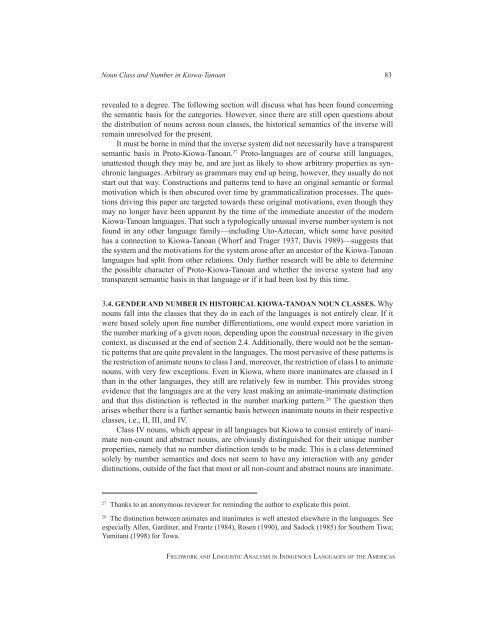Fieldwork and Linguistic Analysis in Indigenous ... - ScholarSpace
Fieldwork and Linguistic Analysis in Indigenous ... - ScholarSpace
Fieldwork and Linguistic Analysis in Indigenous ... - ScholarSpace
Create successful ePaper yourself
Turn your PDF publications into a flip-book with our unique Google optimized e-Paper software.
Noun Class <strong>and</strong> Number <strong>in</strong> Kiowa-Tanoan 83<br />
revealed to a degree. The follow<strong>in</strong>g section will discuss what has been found concern<strong>in</strong>g<br />
the semantic basis for the categories. However, s<strong>in</strong>ce there are still open questions about<br />
the distribution of nouns across noun classes, the historical semantics of the <strong>in</strong>verse will<br />
rema<strong>in</strong> unresolved for the present.<br />
It must be borne <strong>in</strong> m<strong>in</strong>d that the <strong>in</strong>verse system did not necessarily have a transparent<br />
semantic basis <strong>in</strong> Proto-Kiowa-Tanoan. 27 Proto-languages are of course still languages,<br />
unattested though they may be, <strong>and</strong> are just as likely to show arbitrary properties as synchronic<br />
languages. Arbitrary as grammars may end up be<strong>in</strong>g, however, they usually do not<br />
start out that way. Constructions <strong>and</strong> patterns tend to have an orig<strong>in</strong>al semantic or formal<br />
motivation which is then obscured over time by grammaticalization processes. The questions<br />
driv<strong>in</strong>g this paper are targeted towards these orig<strong>in</strong>al motivations, even though they<br />
may no longer have been apparent by the time of the immediate ancestor of the modern<br />
Kiowa-Tanoan languages. That such a typologically unusual <strong>in</strong>verse number system is not<br />
found <strong>in</strong> any other language family—<strong>in</strong>clud<strong>in</strong>g Uto-Aztecan, which some have posited<br />
has a connection to Kiowa-Tanoan (Whorf <strong>and</strong> Trager 1937, Davis 1989)—suggests that<br />
the system <strong>and</strong> the motivations for the system arose after an ancestor of the Kiowa-Tanoan<br />
languages had split from other relations. Only further research will be able to determ<strong>in</strong>e<br />
the possible character of Proto-Kiowa-Tanoan <strong>and</strong> whether the <strong>in</strong>verse system had any<br />
transparent semantic basis <strong>in</strong> that language or if it had been lost by this time.<br />
3.4. GENDER AND NUMBER IN HISTORICAL KIOWA-TANOAN NOUN CLASSES. Why<br />
nouns fall <strong>in</strong>to the classes that they do <strong>in</strong> each of the languages is not entirely clear. If it<br />
were based solely upon f<strong>in</strong>e number differentiations, one would expect more variation <strong>in</strong><br />
the number mark<strong>in</strong>g of a given noun, depend<strong>in</strong>g upon the construal necessary <strong>in</strong> the given<br />
context, as discussed at the end of section 2.4. Additionally, there would not be the semantic<br />
patterns that are quite prevalent <strong>in</strong> the languages. The most pervasive of these patterns is<br />
the restriction of animate nouns to class I <strong>and</strong>, moreover, the restriction of class I to animate<br />
nouns, with very few exceptions. Even <strong>in</strong> Kiowa, where more <strong>in</strong>animates are classed <strong>in</strong> I<br />
than <strong>in</strong> the other languages, they still are relatively few <strong>in</strong> number. This provides strong<br />
evidence that the languages are at the very least mak<strong>in</strong>g an animate-<strong>in</strong>animate dist<strong>in</strong>ction<br />
<strong>and</strong> that this dist<strong>in</strong>ction is reflected <strong>in</strong> the number mark<strong>in</strong>g pattern. 28 The question then<br />
arises whether there is a further semantic basis between <strong>in</strong>animate nouns <strong>in</strong> their respective<br />
classes, i.e., II, III, <strong>and</strong> IV.<br />
Class IV nouns, which appear <strong>in</strong> all languages but Kiowa to consist entirely of <strong>in</strong>animate<br />
non-count <strong>and</strong> abstract nouns, are obviously dist<strong>in</strong>guished for their unique number<br />
properties, namely that no number dist<strong>in</strong>ction tends to be made. This is a class determ<strong>in</strong>ed<br />
solely by number semantics <strong>and</strong> does not seem to have any <strong>in</strong>teraction with any gender<br />
dist<strong>in</strong>ctions, outside of the fact that most or all non-count <strong>and</strong> abstract nouns are <strong>in</strong>animate.<br />
27 Thanks to an anonymous reviewer for rem<strong>in</strong>d<strong>in</strong>g the author to explicate this po<strong>in</strong>t.<br />
28 The dist<strong>in</strong>ction between animates <strong>and</strong> <strong>in</strong>animates is well attested elsewhere <strong>in</strong> the languages. See<br />
especially Allen, Gard<strong>in</strong>er, <strong>and</strong> Frantz (1984), Rosen (1990), <strong>and</strong> Sadock (1985) for Southern Tiwa;<br />
Yumitani (1998) for Towa.<br />
fieldwork <strong>and</strong> l<strong>in</strong>guistic analysis <strong>in</strong> <strong>in</strong>digenous languages of the americas

















